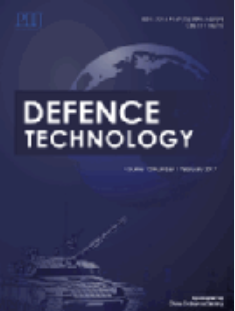棒状反应聚能穿甲弹冲击厚钢板的穿透-爆燃耦合损伤性能
IF 5
Q1 ENGINEERING, MULTIDISCIPLINARY
引用次数: 0
摘要
通过理论分析和实验研究了棒状反应聚能穿甲弹(RRSCP)撞击厚钢板的穿透-爆燃耦合损伤性能。建立了侵彻-爆燃耦合损伤模型,对侵彻深度和弹坑直径进行了预测。选取密度分别为2.3、2.7、3.5和4.5 g·cm−3的4种铝-聚四氟乙烯-铜(Al-PTFE-Cu)反应衬里进行渗透实验。对比结果表明,模型预测与实验数据吻合较好。通过对比惰性侵彻模式和侵彻-爆燃耦合模式下的侵彻深度和爆孔直径,揭示了侵彻诱导的化学反应对侵彻不利而对爆孔效应增强的影响机理。从地层特征、侵彻效应和侵彻诱导的化学反应行为等方面,进一步分析了活性衬里密度对侵彻爆燃性能的影响。结果表明,增加反应性衬套的密度可显著提高反应性侵彻剂的动能和长度,同时有效降低侵彻诱导的化学反应减弱效应,增强侵彻能力。然而,由于反应性侵彻剂的直径和势能含量的减小,其造孔能力明显减弱。本文章由计算机程序翻译,如有差异,请以英文原文为准。
Penetration-deflagration coupling damage performance of rod-like reactive shaped charge penetrator impacting thick steel plates
The penetration-deflagration coupling damage performance of rod-like reactive shaped charge penetrator (RRSCP) impacting thick steel plates is investigated by theoretical analysis and experiments. A penetration-deflagration coupling damage model is developed to predict the penetration depth and cratering diameter. Four type of aluminum-polytetrafluoroethylene-copper (Al-PTFE-Cu) reactive liners with densities of 2.3, 2.7, 3.5, and 4.5 g·cm−3 are selected to conduct the penetration experiments. The comparison results show that model predictions are in good agreement with the experimental data. By comparing the penetration depth and cratering diameter in the inert penetration mode and the penetration-deflagration coupling mode, the influence mechanism that the penetration-induced chemical response is unfavorable to penetration but has an enhanced cratering effect is revealed. From the formation characteristics, penetration effect and penetration-induced chemical reaction behaviors, the influence of reactive liner density on the penetration-deflagration performance is further analyzed. The results show that increasing the density of reactive liner significantly increases both the kinetic energy and length of the reactive penetrator, meanwhile effectively reduces the weakened effect of penetration-induced chemical response, resulting in an enhanced penetration capability. However, due to the decreased diameter and potential energy content of reactive penetrator, the cratering capability is weakened significantly.
求助全文
通过发布文献求助,成功后即可免费获取论文全文。
去求助
来源期刊

Defence Technology(防务技术)
Mechanical Engineering, Control and Systems Engineering, Industrial and Manufacturing Engineering
CiteScore
8.70
自引率
0.00%
发文量
728
审稿时长
25 days
期刊介绍:
Defence Technology, a peer reviewed journal, is published monthly and aims to become the best international academic exchange platform for the research related to defence technology. It publishes original research papers having direct bearing on defence, with a balanced coverage on analytical, experimental, numerical simulation and applied investigations. It covers various disciplines of science, technology and engineering.
 求助内容:
求助内容: 应助结果提醒方式:
应助结果提醒方式:


